Printer Picks
New Epson, C. Itoh, Okidata models reviewed
by Eric Clausen
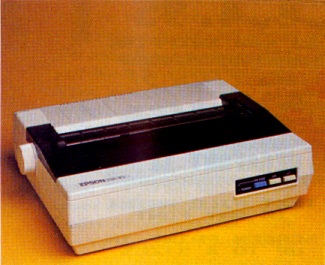
Epson DX-10
Epson's first true letter-quality printer is targeted for the low end of the market at $299. But don't let the price fool you – Epson has come up with a fine product here.
The DX-10 is capable of all the basic functions you'll need from a daisy-wheel printer. Boldface, underlining, subscript and superscript are all supported. In addition, by simple DIP switch selection, both 10 and 12 cpi (characters per inch) are supported without changing print wheels. Other type-styles such as italics require changing the print wheel, which is a simple pop-in process. Ribbon installation is also simple, just snap in a new cartridge.
As of this writing, single-sheet friction feed is standard. A tractor option for pinhole paper is planned, but not yet available. As with most third-party printers for the Atari, a Centronics parallel interface is required.
(For extensive details about printer interfacing, see Antic, March 1985, page 33 and August 1985, page 16. Also, you'll find in-depth explanations of standard printer terminology on pages 23-25 of the March 1985 Antic – ANTIC ED)
Print quality is excellent, as you can see in the accompanying sample. Epson rates the DX-10's speed at 10 cps (characters per second). In testing this printer myself, I found the claim to be quite accurate. In the 10 cpi mode, the printer performed at 9cps, including linefeeds. In the 12 cpi mode, the printer tested out at 9.6 eps.

For this review, I tested the speed of the printers under "real world" conditions – including line feeds and carriage returns that many manufacturers omit from their own rating tests. For each of the printers in this review, I timed the same text file from DOS 2.
Certainly the DX-10 is no speed demon, but when you consider all the fine features of this letter-quality printer for only $299, its slow output seems a relatively small trade-off. It seems as if letter quality for the masses has finally arrived!
And as with many other electronic products, you may soon find this printer discounted at various outlets. If you are thinking of adding a letter quality printer to your system, do yourself a favor and give the DX-10 serious consideration.
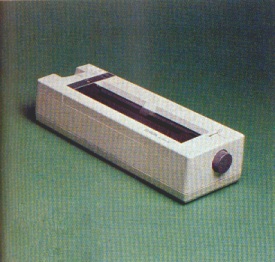
Epson HS-80
Epson's entry in the portable inkjet printer market is its new HS-80 LetterJet printer for $449. Inkjet technology has quickly come a long way. It's remarkable that an inkjet unit this small is available at such a low price.(In this issue, see the article about the Radio Shack Color Printer for a full explanation of inkjet technology. – ANTIC ED.)
The HS-80 measures only 3.14 inches high, 13.5 inches wide and 4.72 inches deep. It is battery powered and weighs a mere 4.18 pounds. You could very easily carry the HS-80 between home and office in your briefcase. This would be ideal if you need a printer on the road, or if you need printers at two locations but only can budget enough for one printer.
Not only is the small size of the HS-80 ideal for transportation, it occupies very little desk space and is very quiet.
However, with any highly specialized printer you can expect some trade-offs. The main trade-offs in the HS-80 involve print quality and speed. This printer is on the slow side, I clocked it at 16.5 cps in correspondence mode and 40 cps in draft mode. And all inkjet printers presently need special paper with a smooth, glossy surface for best results.
I personally did not think that HS-80 print quality was much better than mediocre. For text, most standard dot-matrix printers seem to offer better-looking print. See the HS-80 text samples with this article and judge for yourself. However, as with most of Epson printers, graphics are a high point. The HS-80 was able to produce some very nice graphics dumps from B/GRAPH.
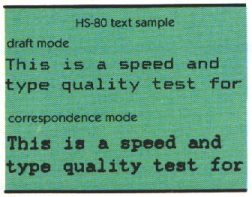
The HS-80 is a normal Centronics parallel printer – you'll need an interface. It can be set up in minutes. Inkjet printers require an ink reservoir which can be messy to handle. Not the HS-80. Filling the ink reservoir has been simplified by special ink "syringes" that mate directly with a port under a cover on the front panel.
DIP switches are easily accessible on the back panel. A variety of printer functions can be manipulated through these switches. This is a battery-powered printer, but an AC adapter is included for recharging. Epson claims you can expect about 300 battery recharges before replacement.
A call to Epson America did not help me determine which other model would be the HS-80's closest relative for software compatibility. It appears that it is relatively close to the LQ-1500 and the FX-80 printers, and you might want to try using these drivers from your particular software package. Unfortunately, this important topic was not covered in the otherwise excellent documentation.
This printer definitely has its place. If portability is important to you, the HS-80 is a good value for your dollar.

C This fast, solid dot-matrix printer is engineered for years of heavy use. C. Itoh has added a near letter quality (NLQ) mode to the already long list of features of their earlier 8510 model. At $549, this is not an entry-level model, and perhaps it would be best suited for an academic or business setting. Even so, the 8510 SEP+ could easily function as your first dot-matrix if you need a printer that's built like a tank.
Virtually everything you will ever need to do with a dot matrix printer is possible with the 8510. Aside from a 9 wire print head, the basic features include: full ASCII character set with true descenders, foreign language character sets, expandable 2K buffer, subscript, superscript, underlining, graphics, cpi modes of 5,8.25, 10 and 16.5, double-strike, near letter quality, 180 cps (manufacturers rating), friction and tractor feed – an impressive list to be sure.
In my own test for speed, I counted the 8510 at a fairly zippy 102 cps in draft mode (including line feeds). I clocked the NLQ mode at 21 cps. The 8510's NLQ mode allows double-width characters and underlining. This printer achieves its NLQ mode by printing each line twice, with a slight offset for the second pass – for a combined matrix of 14 x 18. A print sample of both the NLQ and draft modes can be seen below.
Most of the functions of tile 8510 can be selected from 2 banks of easily accesible DIP switches. Of course, many printer functions can also be controlled from software.
The 8510 does everything well – as it should for $549. The printer has a 10-inch carriage, and both friction and tractor feeds are standard. Again, an interface is required to operate this printer with your Atari. The 8510 has a normal Centronics parallel input on the rear panel. Set-up is easy and the documentation is quite thorough.
If you want almost everything in a dot-matrix printer and don't mind paying a bit more, the C. Itoh 8510 SEP+ may be just for you.
Okidata 193
Okidata has scored a solid hit with its latest entry, the model 193 dot-matrix printer. This is a fast, wide-carriage (15 inch) relative of the older Okidata model 93.
Before I overflow with praise for this fine printer, I should make the point that at $699, the 193 was specifically designed for heavy-duty business applications. Therefore, if you're a casual printer user, the 193 may not be for you.
The Okidata 193 is very easy to set up in a few minutes – even for the most inexperienced user. The documentation is nothing short of great, virtually every aspect of the printer is covered in complete detail, in literate English. The styling of the printer is sleek and ultra-modern. It would blend perfectly into any high-tech decor. The Oki 193 also features a standard Centronics parallel interface and 8K memory buffer.
Beyond the basics, some of the features of the 193 are quite unusual. Users can program 19 functions from the front panel, without DIP switches. This is a great convenience, no more hunting for sometimes well-hidden switches and laboriously figuring out what they do. You simply and easily step through a Menu Select Mode and configure your printer for any conceivable task. These user modifications remain in the printer's memory, even after it's turned off.
Some of these front-panel features include: lines per inch, characters per inch, emphasized and double-width, correspondence mode (same as NLQ), auto line feeds, foreign language fonts, proportional spacing. You may mix many of these various modes to really customize your printed output. Okidata's printer speed claims are much closer to reality than many other manufacturers'. Their draft mode rating was given as 160 cps, while I clocked it at 114 cps. However, they rated the 193's correspondence mode speed at only 33 cps, but I found it to be a faster 36 cps.
The 193 also features dot-addressable graphics which allow highly detailed screen dumps – using proper software – at up to 3,916 dots per line
resolution. The Oki 193 will also accept downloaded fonts and print them in correspondence mode. If you need a printer for very heavy word processing output, or you frequently print out large spreadsheets (you can get 233 characters per line in 17 cpi mode), the 193 is well worth its $699 price.

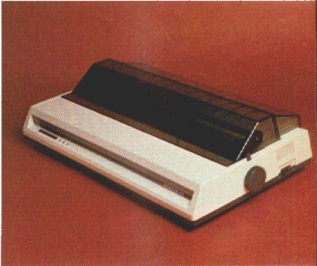
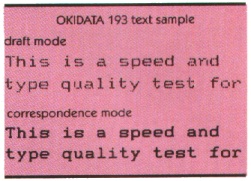
MANUFACTURERS
EPSON DX-10 ($299)
EPSON HS-80 ($449)
Epson America, InC.
2780 Lomita Boulevard
Torrance, CA 90505
(213)539-9140
C. ITOH 8510 SEP+ ($549)
C. Itoh Digital Products
1011 Francisco Street
Torrance, Ca. 90502
(213) 327-5939
OKIDATA 193 ($699)
Okidata
532 Fellowship Road
Mt. Laurel, NJ 08054
(800) OKIDATA